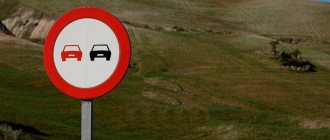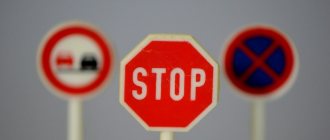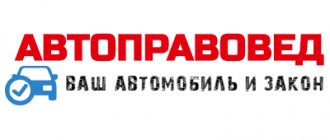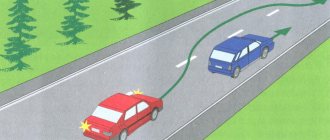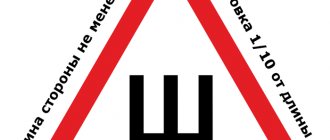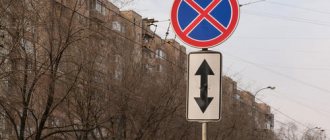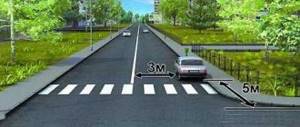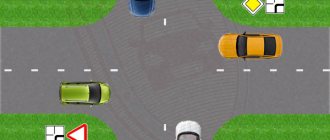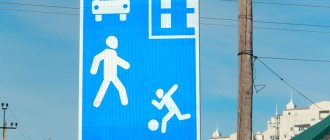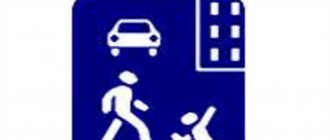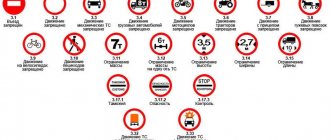What is the new GOST?
In fact, the basic concept of the document remains the same – dating back to 2004. However, many amendments have appeared that bring it into compliance with the Vienna Convention and our local Traffic Rules.
So, the most significant changes:
- in the changed GOST R 52289-2019, rules for the use of road signs appeared, which have long been included in the traffic rules, but were not regulated for installation,
- sign 3.20 Overtaking is prohibited now in all cases must be duplicated on the left of the road - thus eliminating the subtlety when drivers were deprived of their license for overtaking (without markings), which they did not even suspect was prohibited simply because, for example, they were ahead in the oncoming lane the truck that covered this sign,
- The boundaries of paid parking areas are now indicated by intermittent blue markings.
You yourself can compare this new legal act with its previous edition by downloading the document.
.
When does it take effect?
The state standard acquires the status of a valid one on April 1, 2020. This is the official date it comes into force.
Meanwhile, it remains unclear how quickly its instructions will be put into effect. For example, the same requirement to duplicate road sign 3.20 on the left of the roadway - it is obvious that it will take road services a lot of time to install additional signs.
You will also be interested in:
- Are GOSTs mandatory in road traffic or not?
- New GOST about blue and yellow markings in questions and answers
- Is there a fine for waffle markings and what is it?
My own lawyer
According to paragraph 5.4.21 of GOST 52289-2004: signs 3.20 (Overtaking is prohibited) and 3.22 (Overtaking by trucks is prohibited) are installed with one of the plates 8.5.4-8.5.7 (Validity time) on roads with three or fewer lanes in both directions in cases of increased risk of collision with oncoming and passing vehicles, depending on traffic intensity, width and condition of the roadway. Sign 3.20 is installed on sections of roads with poor visibility of an oncoming vehicle; the coverage area of the sign in this case is determined by the length of the dangerous section.
In other words, if there are no “Opening Hours” signs, the sign is installed due to limited visibility. And the effect of the sign according to GOST should be limited to this zone. To do this (clause 5.4.31 of GOST 52289-2004), either the “Overtaking prohibited” sign itself is placed with the “Sign validity area” sign, or the “End overtaking prohibition” sign is installed. Of course, no one denies the effect of the sign to the nearest intersection, if there really is an intersection beyond the visibility zone. Look where the “No Overtaking” sign is posted for oncoming traffic. In most cases, it shows that the coverage area of the sign for your direction of travel has ended and an “End no overtaking” sign should be installed in this place. GOST allows the location of this sign to the left of the road on the reverse side of the “No Overtaking” sign for oncoming traffic. The “Overtaking prohibited” sign is valid until the intersection, and its coverage area can only be reduced by a corresponding sign. The “No Overtaking” sign, in the absence of markings, does not prohibit entering the lane of oncoming traffic. It only prohibits overtaking. That is, if you drove into oncoming traffic to avoid an obstacle in the absence of markings, then there is no and cannot be a punishment. If an inspector draws up a protocol for violating a sign that does not comply with GOST, then first of all the sign must be photographed or videotaped. We photograph or film the signs for oncoming traffic and the absence of any signs and the “End no overtaking” sign. Be sure to write down in the protocol that the sign is not legible or is covered by branches, if this is the case. Upon returning home, on behalf of relatives or friends, indicate on the traffic police website in the “Acceptance of requests” section that the installation of the sign does not comply with GOST. While your case is transferred to the traffic police, while a court hearing is scheduled, the answer may well come that the sign really does not comply with GOST and that order will be restored in the near future. In court, request a traffic management plan and check that the installation of signs complies with the diagram. If in doubt, involve a specialist or expert. Their conclusion is evidence for the court (Part 2 of Article 26.2 of the Administrative Code). Also apply for information on whether a violation of GOST requirements has previously been recorded on this section of the road. You should not find fault with little things. For example, a sign according to GOST should be installed at a height of 1.5 to 3.0 m when installed on the side of the roadway outside populated areas. If the sign is installed at a height of 1.45 m, it is unlikely that the judge will recognize such installation as a significant violation. According to the traffic rules, in the event of a conflict between signs and markings, priority is given to the signs, that is, overtaking in the coverage area of the “Overtaking is prohibited” sign, even through a broken marking line, will result in deprivation of the right to drive under Part 4 of Article 12.15 of the Administrative Code. If there are intermittent markings on the road, followed by a “Overtaking is prohibited” sign and the markings behind it remain intermittent, two options are possible: 1) According to GOST, the “Overtaking is prohibited” sign can be used with a “Sign validity period” sign. Accordingly, overtaking outside the time indicated on the sign is not a violation. 2) The traffic management scheme on this section of the road has been changed, but the markings have not yet been changed. If immediately after the “Overtaking is prohibited” sign there is a continuous marking, and after some distance it again turns into intermittent, then the “Overtaking is prohibited” sign is installed due to visibility restrictions, and at this place the visibility restriction has ended (clause 6.2.3 of GOST 52289-2004). In the cases considered, it is necessary to require the provision of a traffic management plan. It is possible that either a "Sign Hours" sign or an "End No Passing" sign should be installed. If the sign is damaged beyond recognition or simply cut down with a grinder and you overtook in such a situation on intermittent markings, then your actions do not constitute an offense under Part 4 of Article 12.15 of the Administrative Code.
Which changes?
There are a lot of updates to the rules for using signs and markings. You can read all of them in a specially prepared review by RosDorNII.
We will consider the most significant and interesting for ordinary drivers and car enthusiasts.
The No Overtaking sign must be duplicated on the left
GOST 2004 previously had such a requirement. But not for 2-lane roads (one lane in each direction).
From now on, 3.20, as well as 3.22 (Overtaking is prohibited only by trucks) must be duplicated on the left on all roads, except for one-way roads, of course. Here it is not possible to overtake, according to traffic regulations, since there is no oncoming lane.
5.1.6 ... Signs 3.20 and 3.22 are duplicated on roads with one lane for traffic in each direction, sign 5.15.6 - on roads with three lanes for traffic in both directions.
New signs
As we mentioned above, the standard has been supplemented with new road signs in accordance with the requirements of traffic rules and some laws. Here is a list of all the new signs you may see on the roads after the changes.
- 1.35 according to the new GOST indicates the entrance to the intersection with “waffle” markings,
- 3.34 – ban on buses,
- 5.14.2 and 5.14.4 signal the beginning and, respectively, the end of the lane for cyclists,
- 5.35 and 5.36 mean the start and end zones of the zone with the restriction of the environmental class specified in the STS of the vehicle,
- 5.37, 5.38 in addition to the above road signs are valid only for a certain category of cars,
- 5.39 and 5.40 – beginning and end of the cycling zone,
- 7.14.1 symbolizes the customs control point,
- 7.21 – about refueling for electric vehicles,
- plate 8.4.3.1 is already used together with any sign and means that the sign applies to electric vehicles,
- 8.4.15, on the contrary, indicates that the sign does not apply to electric vehicles,
- 8.9.2 indicates that parking here is only possible with a special permit,
- 8.9.3 permits parking or parking only for cars of the diplomatic corps,
- 8.25 indicates that the sign applies to cars of the environmental class written on the plate,
- 8.26 prescribes that there is a charger for electric vehicles in the place symbolized by the road sign.
Cancel reflective surface for some signs
Priority signs are now prohibited from being built into square reflective boxes. Previously, this was rarely used, but it did not contradict GOST.
However, initially the form of such signs was developed with the aim that even from other directions of the roads it would be clear what kind of road signs they were. For example, “Give way” in the form of an inverted rectangle - and there are no other signs of the same shape. The same applies for the main road.
Therefore, now, with changes, this rule has been brought into line with the international Convention.
RFID marking in signs
Now, special chips can be built into structures equipped with retroreflective elements to read these structures (signs, markings and other designations) using special software). Another step towards self-driving cars.
The parking sign still does not cancel the stop ban
Now let’s look at an amendment that did not exist, but which many drivers were waiting for.
The fact is that for many years on the roads of Russia you can find a contradiction of signs, when on a section of the road, for example, with a local widening, there is a sign 6.24, indicating that you can park here. At the same time, 3.27 “Stopping is prohibited” was previously set.
So, the first road sign does not cancel the ban. And why it is needed at all then is not very clear.
The new GOST, unfortunately, did not reveal the answer to this subtlety, and therefore you need to park carefully even with a special sign.
Something else useful for you:
- Long intermittent markings: what does it mean, rules of application, length according to traffic rules and GOST?
- Road sign “Parking prohibited” according to traffic regulations: what is the coverage area, where and who can park?
- Changes in traffic rules in March 2021: new road sign 6.22 Photo and video recording
Blue markings in paid parking lots
In 2021, paid parking or vehicle stop zones may be indicated by intermittent blue markings. Here is an example of such a line given in RosDorNII:
In conclusion, we note that GOST 52289 is mandatory for compliance in the Russian Federation. This means that its instructions must be followed everywhere and without fail. This means that in theory, the absence, for example, of a duplicate no-overtaking sign can help in appealing the traffic police decision.
The traffic police gives signs
In addition, federal cities - Moscow, St. Petersburg, and Sevastopol - will be required to prepare comprehensive traffic management plans. What are they still spared from? And the methodology for calculating parking prices will be approved at the federal level. The corresponding amendments to the law on traffic management were approved by the government commission on legislative activities.
Let us remind you that now the organization of the movement is the prerogative of local authorities. They develop and approve traffic management plans. Any sign that appears on the road must be on this diagram. Without this, it can only appear illegally. Until 2013, draft schemes were required to receive approval from the State Traffic Safety Inspectorate. But then it was considered that the approval procedure was too long, and this requirement was removed.
As a result, there was much more confusion on the road. Absolutely meaningless restrictions and even traps appeared. And, ultimately, the very organization of traffic began to lead to tragedies on the roads. The return of the traffic police functions for coordinating draft schemes has been discussed for a long time. Back in 2021, a corresponding bill was submitted to the State Duma by deputies. However, it was never accepted. This time the bill will be introduced by the government.
However, not all changes in the organization of traffic will require draft schemes that will be coordinated with the traffic police. For example, for carrying out repair work, or blocking traffic in connection with some event, this will not be required.
To carry out road work, if it takes less than two days, a draft traffic management plan will not be needed
An important condition: repairs and traffic closures cannot take more than two days. Now temporary traffic management plans must be drawn up if repairs take more than a day. True, they do not need to be coordinated with the traffic police. Therefore, on a road with a speed limit of 90 km/h, signs with a speed limit of 20 km/h may suddenly appear without a declaration of war.
“For situations where it is necessary to quickly eliminate the consequences of an emergency and repair the road, it is proposed to introduce a simplified procedure for approving a traffic management project. The law prohibits the placement on the road of technical means of traffic management that are not provided for in the documentation for traffic management. Technical means in this case are signs, traffic lights, signal posts, etc.,” Vladimir Gruzdev, Chairman of the Board of the Russian Lawyers Association, commented on the bill to RG.
And it will be possible to notify the population that some parking places suddenly become paid only by publishing information on the Internet. Now it is necessary to publish such information in the media. The main thing is that such a rule does not affect other changes in the organization of traffic, in addition to paid parking. Although the currently established requirements to inform about upcoming changes a month in advance, including with the help of billboards, are often not fulfilled. As a result, it often happens that having parked the car where it could have been parked in the evening, the car owner finds out in the morning that the car was parked in violation of the rules, because a new sign appeared on the street at night.
Meaning of the sign
The road sign “Overtaking is prohibited” does not allow traffic in front of you to pass in the oncoming lane on a designated section of the road. These are usually dangerous areas with poor visibility, slippery surfaces or sharp turns. A prohibitory sign can be installed both in a populated area and outside it, on bridges, overpasses and expressways.
New! The word “moving” was removed from the wording of the definition in the rules, which means you cannot overtake a parked vehicle!
The exception is horse-drawn carts; low-speed vehicles such as a tractor or roller; mopeds, bicycles and motorcycles on two wheels without a cradle.
Attention! The restriction applies to overtaking, but does not prohibit advance!
The driver must distinguish between the concepts of overtaking and advancing: the first type of maneuver is accompanied by driving into oncoming traffic and involves returning back after completion. Advancement is carried out within the boundaries of its lane.
“No overtaking” sign and its coverage area:
